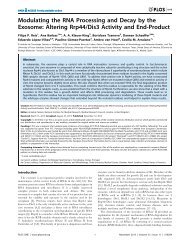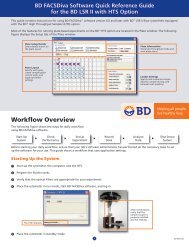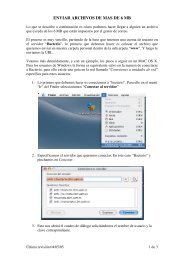Cover Picture: Proteomics 9'11
Cover Picture: Proteomics 9'11
Cover Picture: Proteomics 9'11
- No tags were found...
You also want an ePaper? Increase the reach of your titles
YUMPU automatically turns print PDFs into web optimized ePapers that Google loves.
<strong>Proteomics</strong> 2011, 11, 1559–1568 1567[36] Souchelnytskyi, S., 2008. <strong>Proteomics</strong> in the context ofsystems biology, in: Agrawal, G. K., Rakwal, R. (Eds.), Plant<strong>Proteomics</strong>: Technologies, Strategies, and Applications,Wiley & Sons, Hoboken, NJ 2008, pp. 695–709.[37] Coruzzi, G. M., Rodrigo, A., Guttierrez, R. A., 2009. Plantsystems biology, in: Coruzzi, G. M., Rodrigo, A., Guttierrez,R. A. (Eds.), Annual Plant Reviews, Vol. 35, Wiley-Blackwell,Oxford, UK 2009.[38] Yin, X., Struik, P. C., Modelling the crop: from systemdynamics to systems biology. J. Exp. Bot. 2010, 61,2171–2183.[39] Trewavas, A., Aspects of plant intelligence. Ann. Bot. 2003,92, 1–20.[40] Trewavas, A., Plant intelligence. Naturwissenschaften 2005,92, 401–413.[41] Neilson, K. A., Gammulla, C. G., Mirzaei, M., Imin, N.,Haynes, P. A., Proteomic analysis of temperature stress inplants. <strong>Proteomics</strong> 2010, 10, 828–845.[42] Bradshaw, R. A., Burlingame, A., From proteins to proteomics.IUBMB Life 2005, 57, 267–272.[43] Bevan, M., Walsh, S., The Arabidopsis genome: afoundation for plant research. Genome Res. 2005, 15,1632–1642.[44] Bourguignon, J., Jaquinod, M., An overview of theArabidopsis proteome, in: Agrawal, G. K., Rakwal, R.(Eds.), Plant <strong>Proteomics</strong>: Technologies, Strategies,and Applications, Wiley & Sons, Hoboken, NJ 2008,pp. 143–161.[45] Jones, A. M., Chory, J., Dangl, J. L., Estelle, M. et al., Theimpact of Arabidopsis on human health: diversifying ourportfolio. Cell 2008, 133, 939–943.[46] Van Norman, J. M., Benfey, P. N., Arabidopsis thaliana as amodel organism in systems biology. Wiley Interdiscip. Rev.Syst. Biol. Med. 2009, 1, 372–379.[47] Agrawal, G. K., Rakwal, R., Rice proteomics: a cornerstonefor cereal food crop proteomes. Mass Spectrom. Rev. 2006,25, 1–53.[48] Thiellement, H., Zivy, M., Damerval, C., Mechin, V., Plant<strong>Proteomics</strong>: Methods and Protocols, in: Thiellement, H.,Zivy, M., Damerval, C., Mechin, V. (Eds.), Humana Press,Springer, 2007.[49] Carpentier, S. C., Panis, B., Vertommen, A., Swennen, R.et al., Proteome analysis of non-model plants: a challengingbut powerful approach. Mass Spectrom. Rev. 2008, 27,354–377.[50] Agrawal, G. K., Hajduch, M., Graham, K., Thelen, J. J.,In-depth investigation of the soybean seed-filling proteomeand comparison with a parallel study of rapeseed. PlantPhysiol. 2008, 148, 504–518.[51] Catusse, J., Strub, J. M., Job, C., Van Dorsselaer, A., Job, D.,Proteome-wide characterization of sugarbeet seed vigorand its tissue specific expression. Proc. Natl. Acad. Sci. USA2008, 105, 10262–10267.[52] Tang, W., Kim, T. W., Oses-Prieto, J. A., Sun, Y. et al., BSKsmediate signal transduction from the receptor kinase BRI1in Arabidopsis. Science 2008, 321, 557–560.[53] Tang, W., Deng, Z., Wang, Z. Y., <strong>Proteomics</strong> shed light onthe brassinosteroid signaling mechanisms. Curr. Opin.Plant Biol. 2010, 13, 27–33.[54] Zybailov, B., Friso, G., Kim, J., Rudella, A. et al., Large scalecomparative proteomics of a chloroplast Clp proteasemutant reveals folding stress, altered protein homeostasis,and feedback regulation of metabolism. Mol. Cell. <strong>Proteomics</strong>2009, 8, 1789–1810.[55] Friso, G., Majeran, W., Huang, M., Sun, Q., van Wijk, K. J.,Reconstruction of metabolic pathways, protein expressionand homeostasis machineries across maize bundle sheathand mesophyll chloroplasts; large scale quantitativeproteomics using the first maize genome assembly. PlantPhysiol. 2010, 152, 1219–1250.[56] Lehmann, U., Wienkoop, S., Tschoep, H., Weckwerth, W., Ifthe antibody fails-a mass Western approach. Plant J. 2008,55, 1039–1046.[57] Wienkoop, S., Weiss, J., May, P., Kempa, S. et al., Targetedproteomics for Chlamydomonas reinhardtii combinedwith rapid subcellular protein fractionation, metabolomicsand metabolic flux analysis. Mol. Biosyst. 2010, 6,1018–1031.[58] Millar, A. H., Heazlewood, J. L., Kristensen, B. K., Braun, H.P., Moller, I. M., The plant mitochondrial proteome. TrendsPlant Sci. 2005, 10, 36–43.[59] Kersten, B., Agrawal, G. K., Durek, P., Neigenfind, J. et al.,Plant phosphoproteomics: an update. <strong>Proteomics</strong> 2009, 9,964–988.[60] de la Fuente van Bentem, S., Hirt, H., Protein tyrosinephosphorylation in plants: more abundant than expected?Trends Plant Sci. 2009, 14, 71–76.[61] Zybailov, B., Sun, Q., van Wijk, K. J., Workflow for largescale detection and validation of peptide modifications byRPLC-LTQ-Orbitrap: application to the Arabidopsis thalianaleaf proteome and an online modified peptide library. Anal.Chem. 2009, 81, 8015–8024.[62] Nakagami, H., Sugiyama, N., Mochida, K., Daudi, A. et al.,Large-scale comparative phosphoproteomics identifiesconserved phosphorylation sites in plants. Plant Physiol.2010, 153, 1161–1174.[63] Zhong, J., Haynes, P. A., Zhang, S., Yang, X. et al., Developmentof a system for the study of protein-protein interactionsin planta: characterization of a TATA-box bindingprotein complex in Oryza sativa. J. Proteome Res. 2003, 2,514–522.[64] Rubio, V., Shen, Y., Saijo, Y., Liu, Y. et al., An alternativetandem affinity purification strategy applied toArabidopsis protein complex isolation. Plant J. 2005, 41,767–778.[65] Rohila, J. S., Chen, M., Chen, S., Chen, J. et al., Proteinproteininteractions of tanden affinity purification-taggedprotein kinases in rice. Plant J. 2006, 46, 1–13.[66] Sun, Q., Zybailov, B., Majeran, W., Friso, G. et al., PPDB, thePlant <strong>Proteomics</strong> Database at Cornell. Nucleic Acids Res.2009, 37, D969–D974.[67] Durek, P., Schmidt, R., Heazlewood, J. L., Jones, A. et al.,PhosPhAt: the Arabidopsis thaliana phosphorylation site& 2011 WILEY-VCH Verlag GmbH & Co. KGaA, Weinheimwww.proteomics-journal.com

















